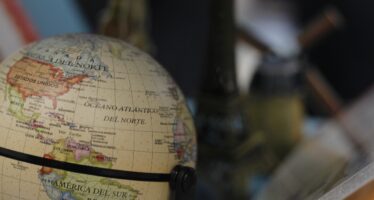Huge tsunami kills hundreds in Japan, sweeps across Pacific
![]()
AP/REUTERS
TOKYO

Houses in flames as the Natori River floods over the surrounding area after the tsunami hit the city of Natori.
The biggest earthquake on record to hit Japan rocked the northeast coast on Friday, triggering a 10-meter tsunami that killed hundreds of people and swept away everything in its path, including houses, ships and cars. The Red Cross in Geneva said the wall of water was higher than some Pacific islands and a tsunami warning was issued for almost the entire Pacific basin, although alerts were lifted for some countries, including Taiwan, Australia and New Zealand.
Up to 300 bodies were found in the coastal city of Sendai, media said. NHK television said the victims appeared to have drowned. The extent of the destruction along a lengthy stretch of coastline suggested the death toll could rise significantly. Some 3,000 residents living near a nuclear plant in Fukushima prefecture, north of Tokyo, were told to evacuate but the government said no radiation was leaking. It said the evacuation was a precaution after a reactor cooling malfunction. Other nuclear power plants and oil refineries were shut down after the 8.9 magnitude quake, while one refinery was ablaze. A major explosion hit a petrochemical complex in Miyagi prefecture after the quake, Kyodo said. Political leaders pushed for an emergency budget to help fund relief efforts after Prime Minister Naoto Ka asked them to ”save the country,” Kyodo news agency reported.
Stunning TV footage showed a muddy wall of water carrying cars and wrecked homes at high speed across farmland near Sendai, home to one million people and which lies 300 kilometers (180 miles) northeast of Tokyo. Ships had been flung onto a harbor wharf, where they lay helplessly on their side. The quake, the most powerful since Japan started keeping records 140 years ago, sparked at least 80 fires in cities and towns along the coast, Kyodo news agency said. A ship carrying 100 people had been swept away by the tsunami, Kyodo said. One train was unaccounted for.
In Tokyo, residents who had earlier fled swaying buildings jammed the streets trying to make their way home after much of the city’s public transportation was shut down. Electronics giant Sony Corp, one of the country’s biggest exporters, shut six factories, as air force jets raced toward the northeast coast to determine the extent of the damage. The Bank of Japan, which has been struggling to boost the anemic economy, said it would do its utmost to ensure financial market stability as the yen and Japanese shares fell.
“I was terrified and I’m still frightened,” said Hidekatsu Hata, 36, manager of a Chinese noodle restaurant in Tokyo, where buildings shook violently. “I’ve never experienced such a big quake before.” The tsunami alerts revived memories of the giant waves which struck Asia in 2004. The Pacific Tsunami Warning Center issued alerts for countries to the west and across the Pacific as far away as Colombia and Peru. The earthquake was the fifth most powerful to hit the world in the past century.
There were several strong aftershocks. In Tokyo, there was widespread panic. An oil refinery near the city was on fire, with dozens of storage tanks under threat. Around 4.4 million homes were without power in northern Japan, media said. “People are flooding the streets. It’s incredible. Everyone is trying to get home but I didn’t see any taxis,” said Koji Goto, a 43-year-old Tokyo resident. NHK television showed flames and black smoke billowing from a building in Odaiba, a Tokyo suburb, and bullet trains to the north of the country were halted. Thick smoke was also pouring out of an industrial area in Yokohama’s Isogo area.

A ferocious tsunami spawned by one of the largest earthquakes ever recorded slammed Japan’s eastern coast Friday, killing hundreds of people as it swept away boats, cars and homes while widespread fires burned out of control. Hours later, the tsunami hit Hawaii and warnings blanketed the Pacific, as far away as South America, Canada, Alaska and the entire US West Coast.
TV showed residents of the city running out of shaking buildings, shielding their heads with their hands from falling masonry. TV footage showed boats, cars and trucks tossed around like toys in the water after a small tsunami hit the town of Kamaichi in northern Japan. An overpass, location unknown, appeared to have collapsed and cars were turning around and speeding away.
“The building shook for what seemed a long time and many people in the newsroom grabbed their helmets and some got under their desks,” Reuters correspondent Linda Sieg said in Tokyo. “It was probably the worst I have felt since I came to Japan more than 20 years ago.”
The US navy said its ships had been unaffected by the tsunami and were ready to provide disaster relief if needed. China offered to provide earthquake relief. The quake struck just before the Tokyo stock market closed, pushing the Nikkei down to end at a five-week low. Nikkei futures trading in Osaka tumbled as much as 4.7 percent in reaction to the news. The disaster also weighed on markets elsewhere. The quake surpasses the Great Kanto quake of Sept. 1, 1923, which had a magnitude of 7.9 and killed more than 140,000 people in the Tokyo area. The 1995 Kobe quake caused $100 billion in damage and was the most expensive natural disaster in history. Economic damage from the 2004 Indian Ocean tsunami was estimated at about $10 billion.
Passengers on a subway line in Tokyo screamed and grabbed other passengers’ hands during the quake. The shaking was so bad it was hard to stand, said Reuters reporter Mariko Katsumura. Hundreds of office workers and shoppers spilled into Hitotsugi Street, a shopping street in Akasaka in downtown Tokyo. Crowds gathered in front of televisions in a shop next to the drugstore for details.
After the shaking from the first quake subsided, crowds watched and pointed to construction cranes on an office building up the street with voices saying, “They’re still shaking!”, “Are they going to fall?” Japan’s northeast Pacific coast, called Sanriku, has suffered from quakes and tsunamis in the past and a 7.2 quake struck on Wednesday. In 1933, a magnitude 8.1 quake in the area killed more than 3,000 people. Earthquakes are common in Japan, one of the world’s most seismically active areas. The country accounts for about 20 percent of the world’s earthquakes of magnitude 6 or greater.
Related Articles
Convención de Minamata sobre Mercurio entra en vigor
![]()
Este 16 de agosto del 2017, entró en vigor la Convención sobre Mercurio suscrita en el 2013, adoptada en la localidad japonesa de Kumamoto
La aprobación del Acuerdo de Escazú por parte de Chile: reflexiones con ocasión del Día Internacional del Ambiente desde Costa Rica
![]()
El pasado 30 de mayo del 2022, dos Comisiones del Senado de Chile (Ambiente y Relaciones Exteriores) aprobaron el Acuerdo de Escazú: lo hicieron con 7 votos a favor y 2 abstenciones
Más fugas de agua radiactiva y más descontrol en Fukushima
![]()
Es una nota de urgencia de la agencia EFE, Tokio, que toma pie en informaciones de la cadena pública nipona




